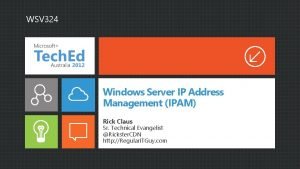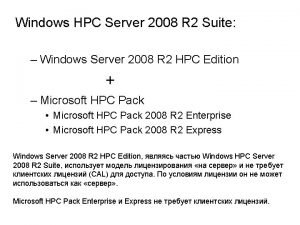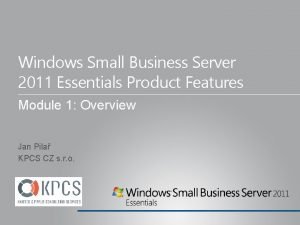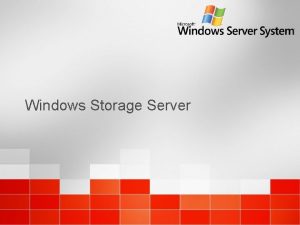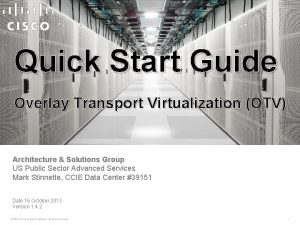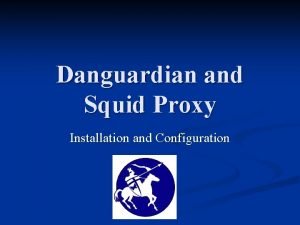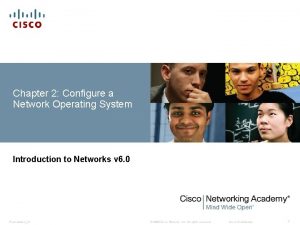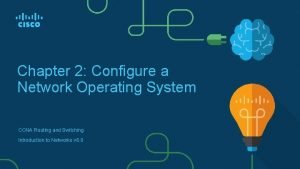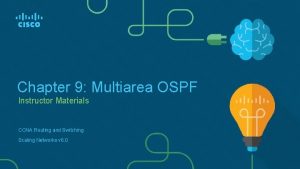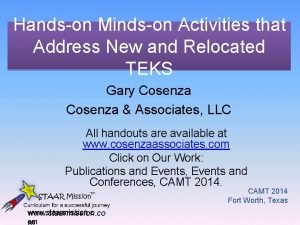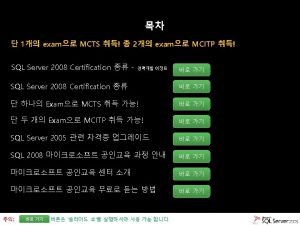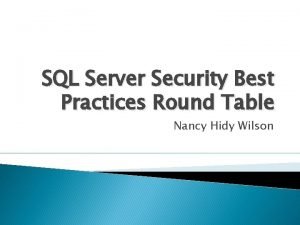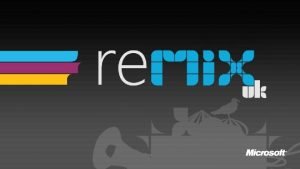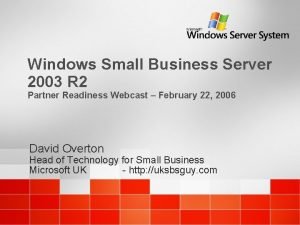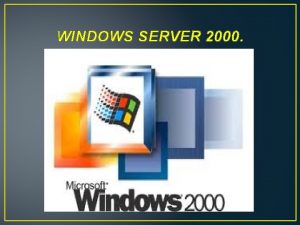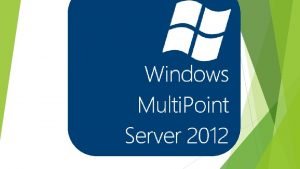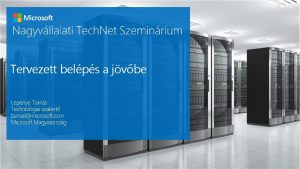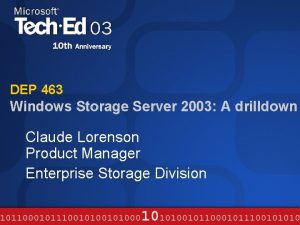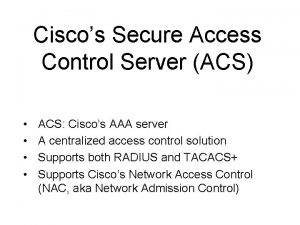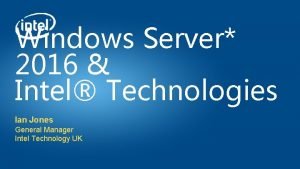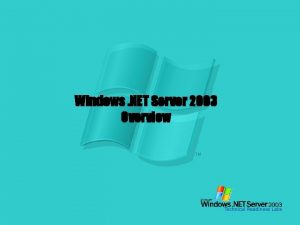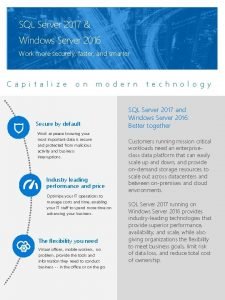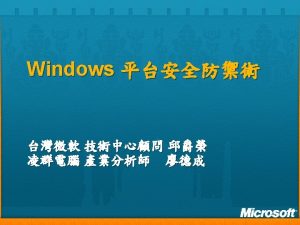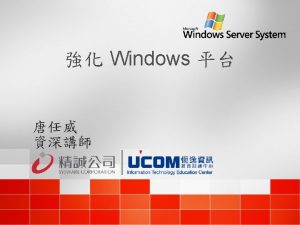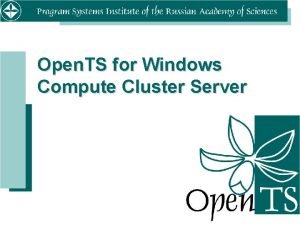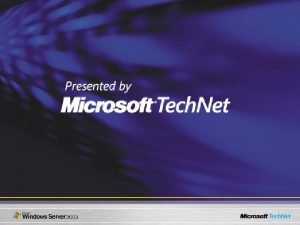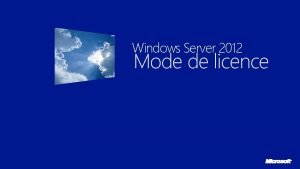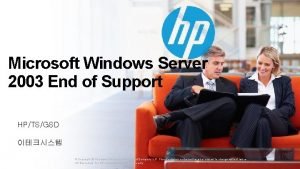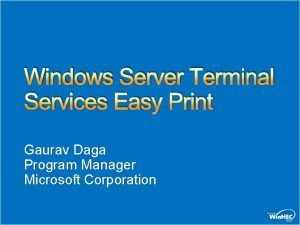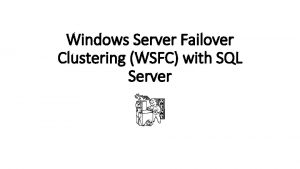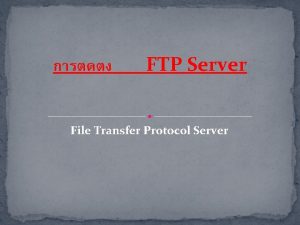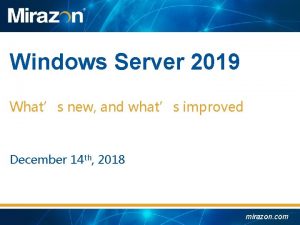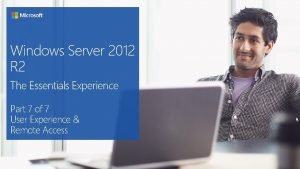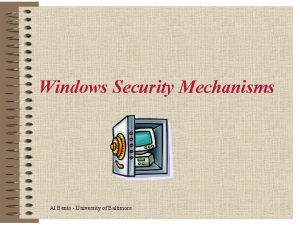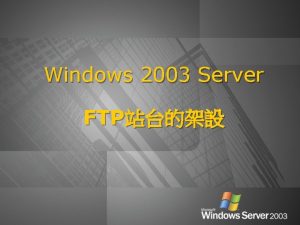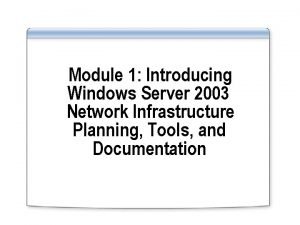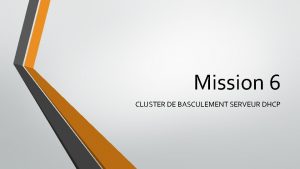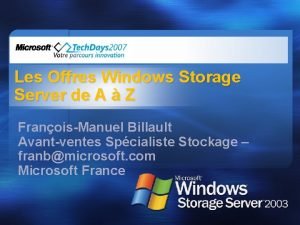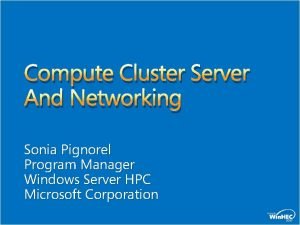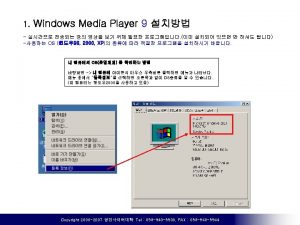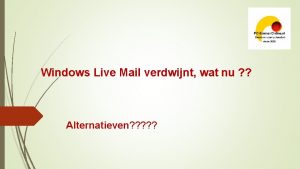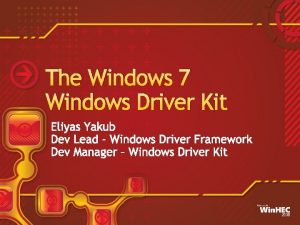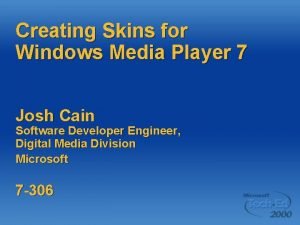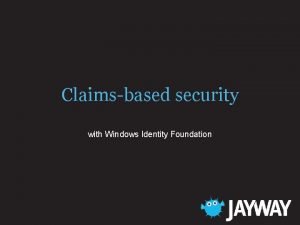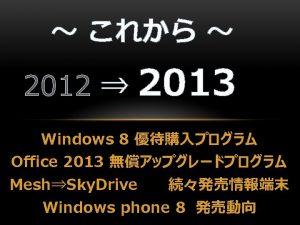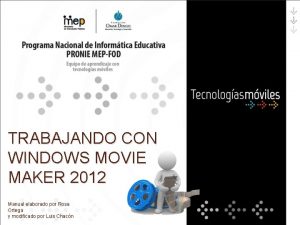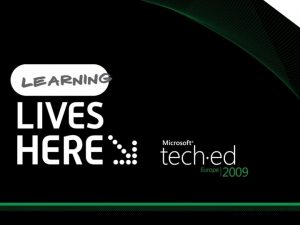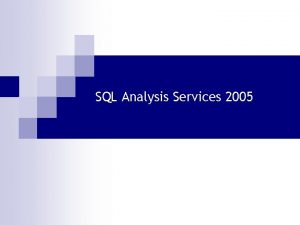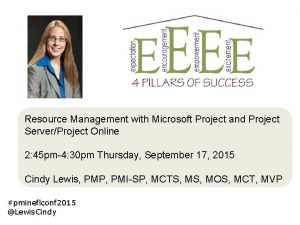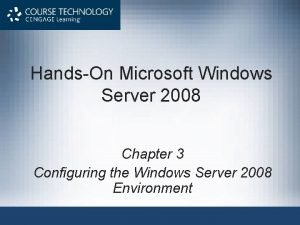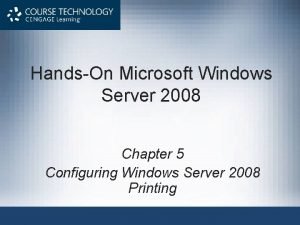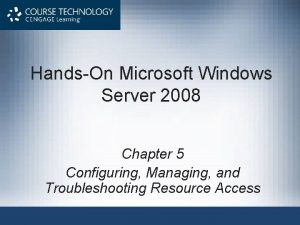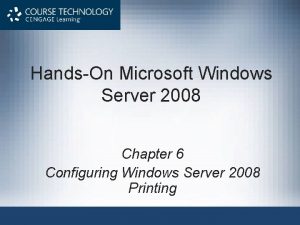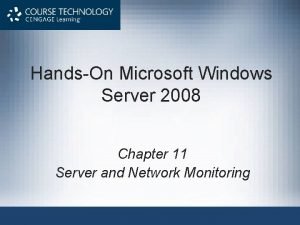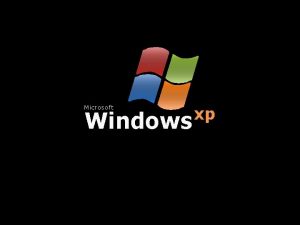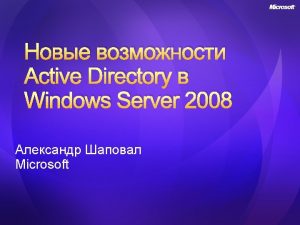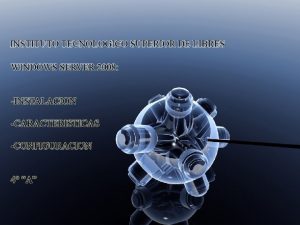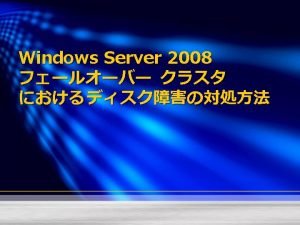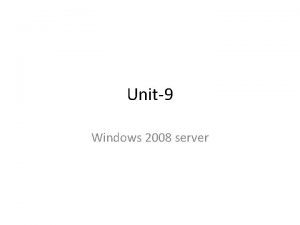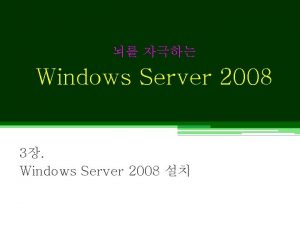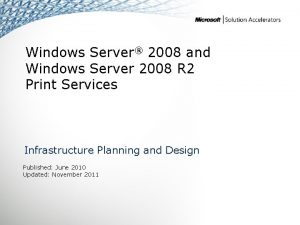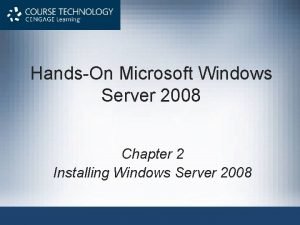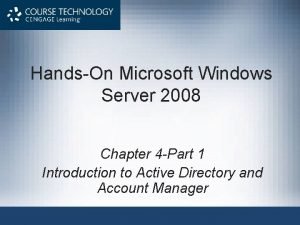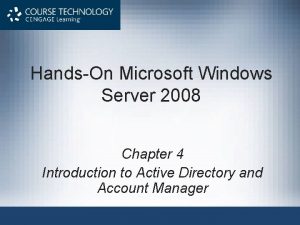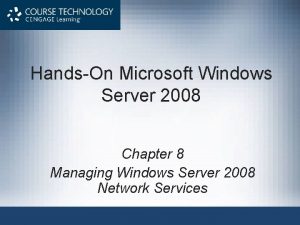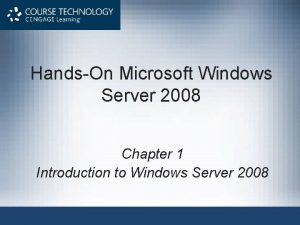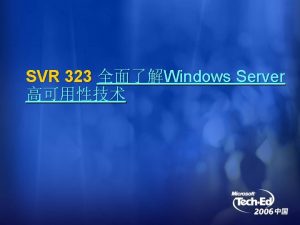HandsOn Microsoft Windows Server 2008 Chapter 7 Configuring





































































- Slides: 69

Hands-On Microsoft Windows Server 2008 Chapter 7 Configuring and Managing Data Storage

Objectives • Understand storage options for Windows Server 2008 • Use the Disk Management tool to configure and manage storage • Explain and configure RAID disk storage fault tolerance • Understand storage enhancements in Windows Server 2008 • Back up disk storage Hands-On Microsoft Windows Server 2008 2

Windows Server 2008 Storage Options • Basic disk – One that uses traditional disk management techniques and contains primary partitions, extended partitions, and logical drives • Dynamic disk – One that does not use traditional partitioning • Dynamic disk architecture provides more flexibility than basic disks – So there is virtually no restriction on the number of volumes that can be on one disk Hands-On Microsoft Windows Server 2008 3

Basic Disks • Partitioning – A process that blocks a group of tracks and sectors to be used by a particular file system, such as NTFS • Formatting – A process that creates a table containing file and folder information for a specific file system in a partition • Volume – A logical designation of disk storage that is created out of one or more physical disks – Is partitioned and formatted with one file system Hands-On Microsoft Windows Server 2008 4

Basic Disks (continued) • Basic disks recognize primary and extended partitions • Basic disks also can be configured for any of three RAID levels: – Disk striping (RAID level 0) – Disk mirroring (RAID level 1) – Disk striping with parity (RAID level 5) • RAID stands for redundant array of inexpensive (or independent) disks – A set of standards for lengthening disk life and preventing data loss Hands-On Microsoft Windows Server 2008 5

Basic Disks (continued) • MBR and GPT support – When a drive is partitioned, a Master Boot Record (MBR) and a partition table are created • At the beginning track and sectors on the disk – The MBR is located in the first sector and track of the hard disk • Has startup information about partitions and how to access the disk – The partition table contains information about each partition created Hands-On Microsoft Windows Server 2008 6

Basic Disks (continued) • MBR and GPT support (continued) – Globally Unique Identifier (GUID) Partition Table or GPT • A newer way to partition disks, without imposing the same type of limits on the number of partitions as with MBR – GPT is one element of the Extensible Firmware Interface (EFI) approach • Offered by the Unified EFI Forum – GPT disks store partition information in each partition using main and backup tables Hands-On Microsoft Windows Server 2008 7

Basic Disks (continued) • Primary and extended partitions on MBR disks – A primary partition is one from which you can boot an operating system – At least one primary partition must be marked as active • Only one primary partition can be active at a given time – The active partition is the partition where your computer will look for the hardware-specific files to start the operating system Hands-On Microsoft Windows Server 2008 8

Basic Disks (continued) • Primary and extended partitions on MBR disks (continued) – An extended partition is created from space that is not yet partitioned – The purpose of an extended partition is to enable you to exceed the four-partition limit of a basic disk – Only one extended partition can exist on a single basic disk • A computer with multiple partitions boots from the partition that is designated as the active partition – Must also be the system partition Hands-On Microsoft Windows Server 2008 9

Hands-On Microsoft Windows Server 2008 10

Basic Disks (continued) • Activity 7 -1: Viewing the Active Partition – Time Required: Approximately 10 minutes – Objective: Verify which partition is marked as active Hands-On Microsoft Windows Server 2008 11

Basic Disks (continued) • Activity 7 -2: Customizing the MMC to Access Disk Management Tools – Time Required: Approximately 10 minutes – Objective: Create a customized console from which to perform disk management and disk defragmentation Hands-On Microsoft Windows Server 2008 12

Basic Disks (continued) • Volume and Stripe Sets – Volume set • Consists of two or more partitions that are combined to look like one volume with a single drive letter – Stripe set • Two or more disks that are combined like a volume set, but that are striped for RAID level 0 or RAID level 5 Hands-On Microsoft Windows Server 2008 13

Dynamic Disks • A dynamic disk does not use traditional partitioning – Makes it possible to set up a large number of volumes on one disk – Provides the ability to extend volumes onto additional physical disks • The number of disks that can be incorporated into one spanned volume is limited to 32 • Plan to convert basic disks to dynamic disks after you install Windows Server 2008 Hands-On Microsoft Windows Server 2008 14

Dynamic Disks (continued) • Simple volume – A portion of a disk or an entire disk that is set up as a dynamic disk – Can be extended onto multiple sections of the same disk • Spanned volume – Stored on 2 to 32 dynamic disks that are treated as one volume – As you add new disks, the spanned volume can be extended to include each disk Hands-On Microsoft Windows Server 2008 15

Hands-On Microsoft Windows Server 2008 16

Dynamic Disks (continued) • Striped volumes – Often referred to as RAID-0 – Extend the life of hard disk drives by spreading data equally over two or more drives – Another advantage: increases disk performance – In Windows Server 2008, striping requires at least two disks and can be performed over as many as 32 – Data can be lost when one or more disks in the striped volume fail because the system has no automated way to rebuild data Hands-On Microsoft Windows Server 2008 17

Hands-On Microsoft Windows Server 2008 18

Dynamic Disks (continued) • Shrinking a volume – Windows Server 2008 comes with the ability to shrink a basic or dynamic disk volume – Shrinking a volume enables you to create a new partition when one is needed and you don’t have extra disks – When you shrink a volume, Windows Server 2008 starts from the end of that volume • Works its way back through contiguous space to create unallocated disk space – You can specify the amount of space to recover Hands-On Microsoft Windows Server 2008 19

Hands-On Microsoft Windows Server 2008 20

Disk Management • Disk Management tool – Provides a central location for viewing disk information and performing tasks such as creating and deleting partitions and volumes Hands-On Microsoft Windows Server 2008 21

Creating a Partition and Simple Volume • Partitions operate as separate storage units on a hard disk • The most basic way to create a partition is to take unallocated disk space – Use the New Simple Volume Wizard to create a simple volume • You can also delete a partition using the Disk Management tool • Once a partition is formatted, it is called a volume and can be assigned a drive letter Hands-On Microsoft Windows Server 2008 22

Creating a Partition and Simple Volume (continued) • Activity 7 -3: Creating a Simple Volume – Time Required: Approximately 10– 30 minutes – Objective: Create a new partition from unpartitioned disk space Hands-On Microsoft Windows Server 2008 23

Converting a Partitioned Basic Disk to a Dynamic Disk • Activity 7 -4: Converting a Basic Disk – Time Required: Approximately 10 minutes – Objective: Convert a simple basic disk to a dynamic disk Hands-On Microsoft Windows Server 2008 24

Mounting a Drive • Windows Server 2008 enables you to mount a drive as an alternative to giving it a drive letter • Mounted drive – One that appears as a folder and is accessed through a path like any other folder • You can mount a basic or dynamic disk drive, a CD/DVD drive, or a removable drive • Home directory or home folder – A server folder that is associated with a user’s account and that is a designated workspace for the user to store files Hands-On Microsoft Windows Server 2008 25

Mounting a Drive (continued) • Activity 7 -5: Configuring a Mounted Drive – Time Required: Approximately 10– 15 minutes – Objective: Learn how to set up a mounted drive Hands-On Microsoft Windows Server 2008 26

Managing Disks • Using Disk Defragmenter – When you save a file to a disk, Windows Server 2008 saves the file to the first area of available space – The file might not be saved to a contiguous area of free space • The disk gradually becomes fragmented • The process of defragmenting – Locates fragmented folders and files and moves them to a location on the physical disk so they are in contiguous order Hands-On Microsoft Windows Server 2008 27

Managing Disks (continued) • Activity 7 -6: Using the Disk Defragmenter – Time Required: Approximately 15 minutes – Objective: Practice using Disk Defragmenter Hands-On Microsoft Windows Server 2008 28

Managing Disks (continued) • Using Disk Check – The Disk Check tool allows you to scan your disk for bad sectors and file system errors • This tool is meant for use when no users need to access the files on the disk you want to check – Because the disk is made unavailable during the scan for problems • Options: – Automatically fix file system errors – Scan for and attempt recovery of bad sectors Hands-On Microsoft Windows Server 2008 29

Managing Disks (continued) • Activity 7 -7: Using Disk Check – Time Required: Depends on the size of the disk and number of files (10 to over 40 minutes) – Objective: Learn how to use Disk Check Hands-On Microsoft Windows Server 2008 30

Managing Disks (continued) • Using chkdsk – You can also check your disk for errors by running the chkdsk utility from the Command Prompt window – In NTFS, chkdsk checks files, folders, indexes, security descriptors, user files, sectors, and disk allocation units Hands-On Microsoft Windows Server 2008 31

Managing Disks (continued) Hands-On Microsoft Windows Server 2008 32

Managing Disks (continued) • Activity 7 -8: Using chkdsk from the Command Line – Time Required: Depends on the size of the disk and number of files (10 to over 40 minutes) – Objective: Learn how to use chkdsk from the command line Hands-On Microsoft Windows Server 2008 33

Introduction to Fault Tolerance • Fault tolerance – The ability of a system to gracefully recover from hardware or software failure • Windows Server 2008 provides a level of fault tolerance through software-level RAID • With fault tolerance, data is written to more than one drive – In the event one drive fails, data can still be accessed from one of the remaining drives Hands-On Microsoft Windows Server 2008 34

RAID Volumes • RAID is a set of standards for lengthening disk life, preventing data loss, and enabling relatively uninterrupted access to data • RAID level 0 – Striping with no other redundancy features is RAID level 0 • RAID level 1 – Disk duplexing is the same as disk mirroring, with the exception that it places the backup disk on a different controller or adapter than is used by the main disk Hands-On Microsoft Windows Server 2008 35

Hands-On Microsoft Windows Server 2008 36

RAID Volumes (continued) • RAID level 2 – Uses an array of disks whereby the data is striped across all disks in the array • RAID level 3 – Uses disk striping and stores error-correcting information, but the information is only written to one disk in the array • RAID level 4 – Stripes data and stores error-correcting information on all drives Hands-On Microsoft Windows Server 2008 37

RAID Volumes (continued) • RAID level 5 – Combines the best features of RAID, including striping, error correction, and checksum verification • Windows Server 2008 supports RAID levels 0, 1, and 5 for disk fault tolerance Hands-On Microsoft Windows Server 2008 38

Using a Striped Volume (RAID-0) • Reasons for using a RAID level 0 or a striped volume in Windows Server 2008 are to: – Reduce the wear on multiple disk drives by equally spreading the load – Increase disk performance compared with other methods for configuring dynamic disk volumes • To create a striped volume, right-click the unallocated space for the volume and click New Striped Volume • Only dynamic disks can be striped volumes Hands-On Microsoft Windows Server 2008 39

Using a Mirrored Volume (RAID-1) • Disk mirroring involves creating a shadow copy of data on a backup disk • Only dynamic disks can be set up as a mirrored volume in Windows Server 2008 • One of the most guaranteed forms of disk fault tolerance • Disk read performance is the same as reading data from any single disk drive • A mirrored volume is created through the Disk Management tool Hands-On Microsoft Windows Server 2008 40

Using a RAID-5 Volume • Fault tolerance is better for a RAID-5 volume • A RAID-5 volume requires a minimum of three disk drives • Parity information is distributed on each disk – If one disk fails, the information on that disk can be reconstructed – The parity used by Microsoft is Boolean (true/false, one/zero) logic Hands-On Microsoft Windows Server 2008 41

Hands-On Microsoft Windows Server 2008 42

Using a RAID-5 Volume (continued) • The performance is not as fast as with a striped volume – Takes longer to write the data and calculate the parity block for each row • Accessing data through disk reads is as fast as a striped volume • A RAID-5 volume is particularly useful in a client/server system that uses a separate database for queries and creating reports • Use the Disk Management tool to create a RAID-5 volume Hands-On Microsoft Windows Server 2008 43

Software RAID vs. Hardware RAID • Software RAID implements fault tolerance through the server’s operating system • Hardware RAID is implemented through the server hardware – Independent of the operating system • Advantages over software RAID: – Faster read and write response – The ability to place boot and system files on different RAID levels – The ability to ‘‘hot-swap’’ a failed disk – More setup options to retrieve damaged data Hands-On Microsoft Windows Server 2008 44

Windows Server 2008 Storage Enhancements • For medium to large networks, Windows Server 2008 offers storage enhancements in two important realms: – Management of Storage Area Networks – Using multiple paths to storage for fault tolerance Hands-On Microsoft Windows Server 2008 45

Storage Manager for SANs • Storage Area Network (SAN) – A grouping of storage devices that forms a subnet • The storage devices are available to any server on the main network – Appear to the user as though they are attached to the server they are accessing • Typically, the subnet containing the storage devices uses Fibre Channel or i. SCSI technology • Storage Manager for SANs is used to manage the logical unit numbers for Small Computer System Interface drives Hands-On Microsoft Windows Server 2008 46

Storage Manager for SANs (continued) • Small Computer System Interface (SCSI) – A 32 - or 64 -bit computer adapter that transports data between one or more attached devices and the computer • Logical unit number (LUN) – A number that identifies a physical SCSI drive or logical SCSI targets • A SAN containing multiple drives configured for RAID will have many LUNs to manage • Storage Manager for SANs is used for SANs that employ Virtual Disk Service Hands-On Microsoft Windows Server 2008 47

Storage Manager for SANs (continued) • Virtual Disk Service (VDS) – Used to enable management of disk volumes in SANs through one interface at a server • Another enhancement to Windows Server 2008 is that the i. SCSI initiator is now built into the operating system – The i. SCSI initiator is a driver that enables Windows Server 2008 to communicate with an i. SCSI SAN Hands-On Microsoft Windows Server 2008 48

Multipath Input/Output Enhancements • Multipath I/O – Provides a means to establish multiple paths between a server and its disk storage • The first step in this process is to create the multiple paths between the storage and the server or servers – For a SAN, creating multiple paths might involve establishing two or more network paths through two or more network switches to the SAN • The next step is to install Multipath I/O – A feature installed through Server Manager Hands-On Microsoft Windows Server 2008 49

Multipath Input/Output Enhancements (continued) • Device Specific Module (DSM) – Compatible with the following disk storage array controller technologies: • Asymmetric logical unit access (ALUA) • Active/Active controller model • Configuration models: – – Dynamic Least Queue Depth Failback Failover Round Robin Hands-On Microsoft Windows Server 2008 50

Multipath Input/Output Enhancements (continued) • Configuration models: (continued) – Round Robin with a subset of paths – Weighted Path Hands-On Microsoft Windows Server 2008 51

Disk Backup • One of the best ways to make sure you do not lose valuable information on a hard disk is to fully back up information on a regular basis – These backups can be performed from the server or from a workstation on the network • Performing backups from a backup device installed on the server has several advantages: – No extra load is produced on the network – Perform backups on a multiple-server network – Provides more assurance that the Registry is backed up Hands-On Microsoft Windows Server 2008 52

Disk Backup (continued) • The advantages of performing a network backup – Backup jobs can be stored on a single backup media – One administrator can be responsible for backing up multiple servers • The main disadvantages – The increase in network traffic – The Registry cannot be backed up from across the network Hands-On Microsoft Windows Server 2008 53

Windows Server Backup • Windows Server Backup tool offers the ability to back up all server files or files that have changed • Enhancements in Windows Server 2008: – Is easier to recover from a backup – Has more backup options, including using the Volume Shadow Copy Service (VSS) – Is more reliable in recovering applications – Provides information about disk use – Offers the wbadmin command-line tool – Has full support to back up to optical media Hands-On Microsoft Windows Server 2008 54

Windows Server Backup (continued) • Considerations for using Windows Server Backup – Tool only backs up NTFS volumes – Tool does not back up to tape – If you have backup media made from Windows Server 2003 using Ntbackup. exe, you cannot restore from that media using the Windows Server Backup tool in Windows Server 2008 Hands-On Microsoft Windows Server 2008 55

Windows Server Backup (continued) • Activity 7 -9: Installing the Windows Server Backup Tool – Time Required: Approximately 10 minutes – Objective: Install the Windows Server Backup tool Hands-On Microsoft Windows Server 2008 56

Backup Options • Full backup – A backup of an entire system, including all system files, programs, and data files – Changes each file’s archive attribute to show that it has been backed up • Incremental backup – Only backs up files that are new or that have been updated – Backs up only files that have the archive attribute marked Hands-On Microsoft Windows Server 2008 57

Backup Options (continued) • Custom backup – Enables you to configure backups differently for each volume • Such as doing an incremental backup every time you back up the C drive and a full backup each time you back up the D drive Hands-On Microsoft Windows Server 2008 58

Backup Options (continued) • Activity 7 -10: Backing Up a Server – Time Required: Approximately 10 to 30 minutes – Objective: Perform a full backup Hands-On Microsoft Windows Server 2008 59

Scheduling Backups • Windows Server Backup includes a scheduling capability – Can have the server automatically start backups after regular work hours or at a specific time of day Hands-On Microsoft Windows Server 2008 60

Hands-On Microsoft Windows Server 2008 61

Hands-On Microsoft Windows Server 2008 62

Configuring Backup Performance • Configuring the backup performance options enables you to specify which types of backups to perform: full, incremental, and custom • The default is to always perform full backups Hands-On Microsoft Windows Server 2008 63

Hands-On Microsoft Windows Server 2008 64

Performing a Recovery • The Windows Server Backup tool enables you to recover any of the following: – – – Files Folders Volumes Applications and application data The backup catalog (of information in the backup) The operating system (to the same computer or to another computer using identical hardware) Hands-On Microsoft Windows Server 2008 65

Performing a Recovery (continued) • Before you start, determine the following information: – Date of the backup from which to recover – Type of recovery, such as files and folders or applications – What to recover – Where to recover, such as in the original location or another location Hands-On Microsoft Windows Server 2008 66

Summary • Windows Server 2008 uses basic and dynamic disks • Dynamic disks can be configured as simple, spanned, striped, mirrored, and RAID-5 volumes • If you need to recover space from a basic or dynamic disk, you can shrink the disk • The Disk Management tool enables you to create basic and dynamic disks • For optimum disk performance, plan to set up a schedule to regularly defragment disks on a server Hands-On Microsoft Windows Server 2008 67

Summary (continued) • Use the Disk Check and chkdsk tools to find and repair disk problems • RAID provides fault tolerance for hard disks • RAID level 0 is disk striping • With disk mirroring or duplexing (RAID level 1), the same data is written to a partition on each of the two disks included in the mirror • With RAID level 5, data is written across a minimum of three disks Hands-On Microsoft Windows Server 2008 68

Summary (continued) • Two important enhancements for Windows Server 2008 include new features for Storage Manager for SANs and features for Multipath I/O • Windows Server Backup offers features to schedule backups, perform full or incremental backups (or a combination of both), and recover data from backups Hands-On Microsoft Windows Server 2008 69
 Windows server ipam
Windows server ipam Windows server 2008
Windows server 2008 Sql server 2005 management studio
Sql server 2005 management studio Small business server 2010
Small business server 2010 Windows small business server 2011 essentials
Windows small business server 2011 essentials Windows storage server 2003
Windows storage server 2003 Microsoft windows movie maker
Microsoft windows movie maker Rosemarie rizzo parse theory application
Rosemarie rizzo parse theory application Configuring otv
Configuring otv Configuring dansguardian
Configuring dansguardian Configure a network operating system
Configure a network operating system Configuring a network operating system
Configuring a network operating system Packet tracer configuring multiarea ospfv2
Packet tracer configuring multiarea ospfv2 2008 2008
2008 2008 This is the religion that god accepts
This is the religion that god accepts Alsa routing
Alsa routing A handson
A handson James handson
James handson James handson
James handson A handson
A handson Handson activities
Handson activities Handson activities
Handson activities Handson session
Handson session Sql server 2008 certification
Sql server 2008 certification Sql security best practices
Sql security best practices Microsoft robotics developer studio 2008
Microsoft robotics developer studio 2008 Windows small business server 2003
Windows small business server 2003 Windows server 2000 caracteristicas
Windows server 2000 caracteristicas Multipoint dashboard
Multipoint dashboard Windows server migration tools
Windows server migration tools Windows storage server 2003
Windows storage server 2003 Cisco secure access control server for windows
Cisco secure access control server for windows Windows codename longhorn
Windows codename longhorn Networking with windows server 2016
Networking with windows server 2016 Net server 2003
Net server 2003 Sql server 2017 windows 7
Sql server 2017 windows 7 Nouveauté windows server 2016
Nouveauté windows server 2016 Windows server 2012 r2 essentials
Windows server 2012 r2 essentials Dlna server windows 10
Dlna server windows 10 Windows 2003 service pack
Windows 2003 service pack Windows compute cluster
Windows compute cluster Windows server 2003 developer
Windows server 2003 developer Eol windows server 2012
Eol windows server 2012 Windows server 2003 eos
Windows server 2003 eos What is wins
What is wins Terminal server printer
Terminal server printer Windows server failover clustering (wsfc)
Windows server failover clustering (wsfc) งช
งช Lcow windows server 2019
Lcow windows server 2019 Windows server 2012 essentials launchpad download
Windows server 2012 essentials launchpad download Bento windows 8
Bento windows 8 Ftp server windows 2003
Ftp server windows 2003 School planning team organizational structure
School planning team organizational structure Cluster dhcp
Cluster dhcp Microsoft storage server
Microsoft storage server Compute cluster server
Compute cluster server Movie
Movie Windows 2000 media player
Windows 2000 media player Alternatief voor windows live mail
Alternatief voor windows live mail Windows driver kit windows 7
Windows driver kit windows 7 Windows media player themes
Windows media player themes Windows identity foundation windows 10
Windows identity foundation windows 10 Upgrade windows 7 to windows 10
Upgrade windows 7 to windows 10 Windows xp virtual machine download free
Windows xp virtual machine download free Windows mobile center windows 10
Windows mobile center windows 10 Movie maker 2012
Movie maker 2012 Windows vista windows 10
Windows vista windows 10 Xp mode key
Xp mode key Microsoft sql server 2005 analysis services
Microsoft sql server 2005 analysis services Microsoft project server resource management
Microsoft project server resource management
